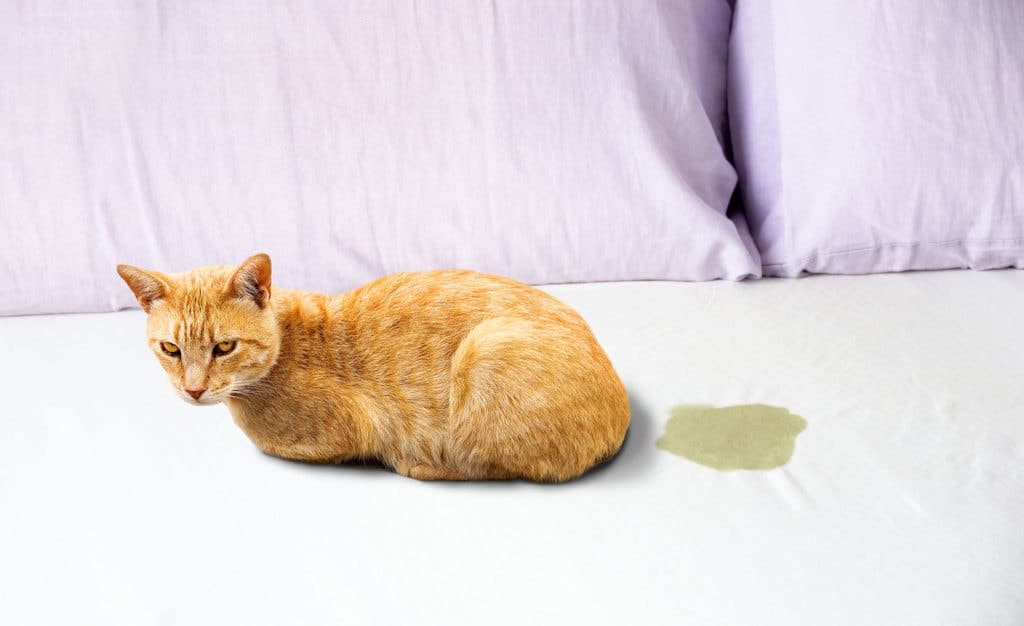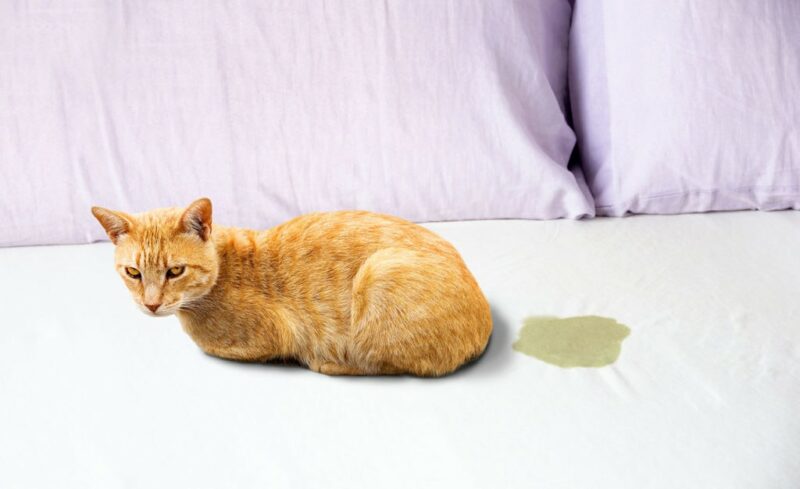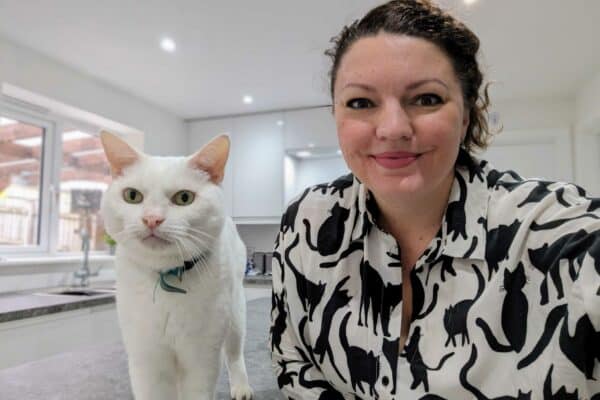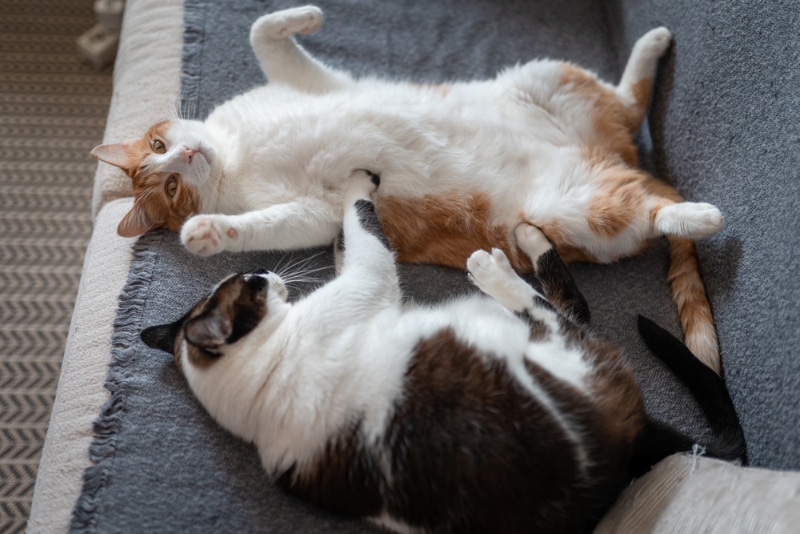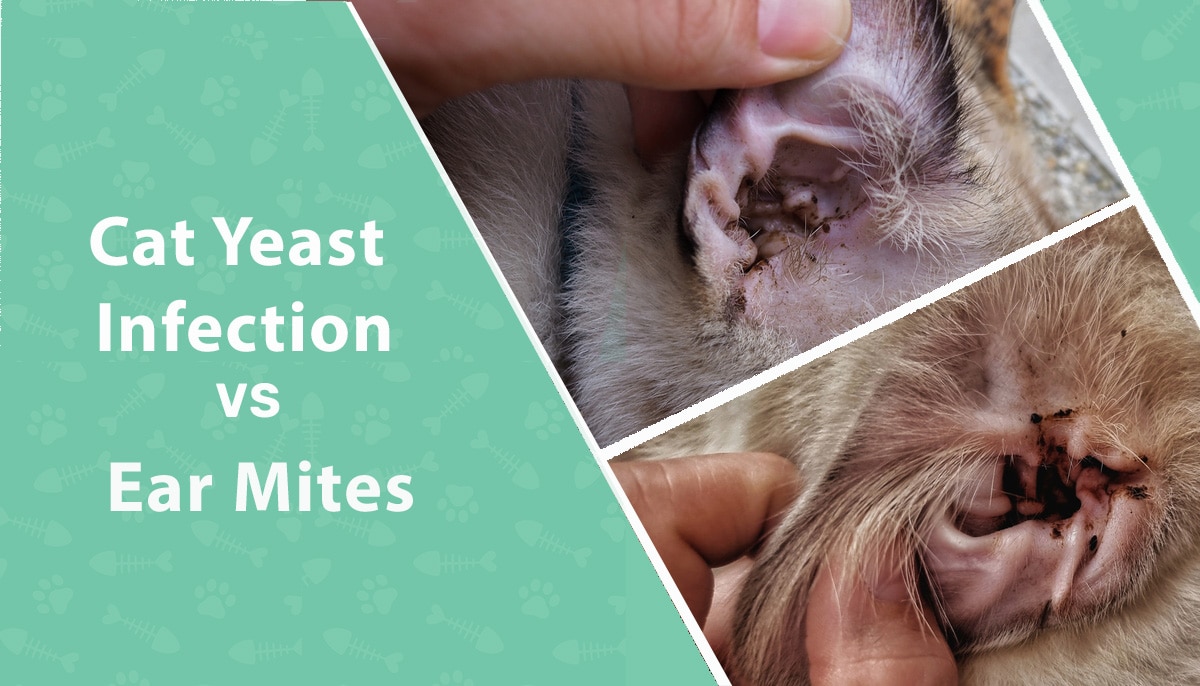Cats naturally take to litter boxes very well, so it’s alarming when your cat stops using the litter box and starts peeing on your bed or couch. Improper urination on furniture is sadly quite common, and it doesn’t help matters that it can be a very complex situation. Certain illnesses can cause spontaneous inappropriate urination in cats, as can stress, or just a plain old dislike for their litter box. It could even be a mix of these things. To help you get to the bottom of the matter and save your furniture, check out some of the most common reasons for a cat peeing on couches down below.
The 6 Common Reasons Cats Pee on Furniture
Why do cats pee on the bed? A cat peeing on furniture can be from a variety of reasons. Before we dive into the most common ones, please note that any change in your cat’s behavior should be concerning, and we strongly urge you to contact your vet as soon as possible to get them checked out.
1. Medical Issues
Many feline health conditions can cause improper urination by impeding your cat’s bladder cosmentrol or causing discomfort or pain. Even more minor ailments that change your cat’s behavior can affect where and when they go to the litter box, so making prompt diagnosis imperative. Before you call your vet, let’s review some of the most common medical problems that can cause your cat to pee on your furniture.
- Urinary tract infection (UTI): Infection causing urinary tract inflammation can cause painful urination, frequent urination, straining to urinate, and longer-than-usual litter box trips.
- Crystalluria: A painful urinary condition where crystals form in the urine, often caused by a perfect storm of genetics, diet, and dehydration.
- Bladder stones: Stones in the bladder or urinary tract can cause intense sudden urges to urinate, cause painful urination, and block the urinary tract in severe cases, necessitating surgical removal. These stones form over time from the same material as urinary crystals.
- Idiopathic cystitis: This painful bladder condition is often accompanied by blood in the urine, but without urine crystals or bacteria. The exact cause remains elusive to this day, but is most likely associated with stress; either behavioral or physiological.
- Metabolic disease: Liver and kidney disease can cause changes in urination and how much your cat drinks, as can diabetes.
- Incontinence: Although not as common in cats as it is in dogs, incontinence can occur in cats. It is usually associated with infection or cystitis, but can also be the result of nerve damage from trauma. The hallmark of this is dribbling urine and leaving puddles where they sit and lie.
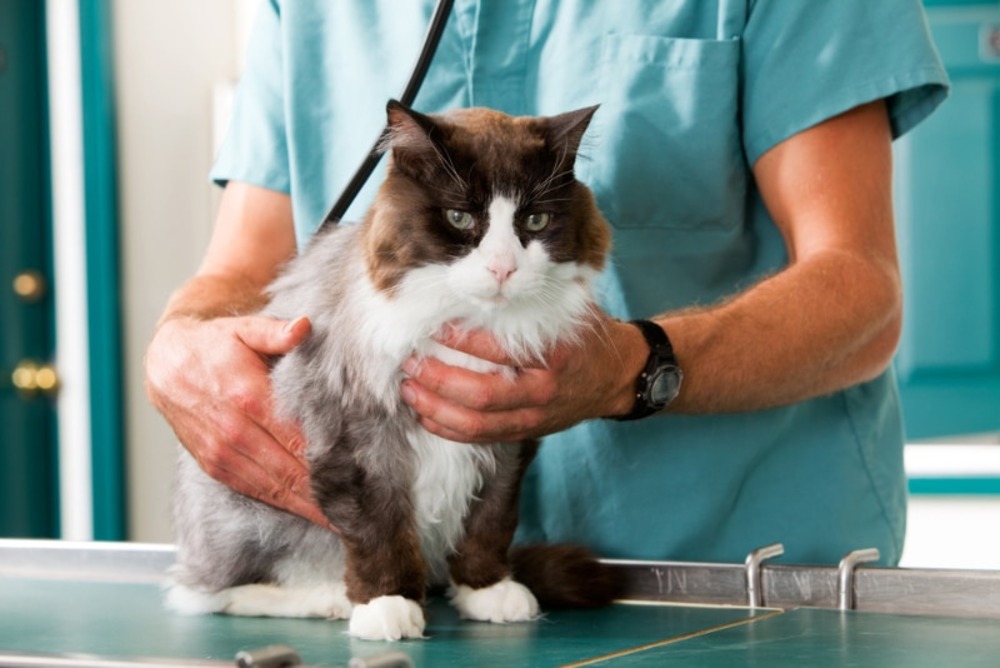
2. They Dislike the Type of Cat Litter You Use
It’s an inexplicable fact of life that your cat won’t always approve of what you do, even if you have their best interests at heart. If they don’t like the texture, smell, or some other inscrutable characteristics of the particular cat litter you choose, they may simply choose to ignore it and go elsewhere. It’s not revenge or protest—they just don’t like it, and you can’t make them use it. Choosing a different type of cat litter—maybe one that’s softer on their paws or has no scent—will likely clear this up in a jiff. If this happened after you recently made a change in litter, then you might want to consider going back to their old brand.
If you're dealing with stubborn smells in your litter box or elsewhere in your house, a good cat litter deodorizer can work wonders.
We recommend Hepper's Advanced Bio-Enzyme Cat Litter Deodorizer, an all-natural litter additive that fights odors using bio-enzymes. This effective deodorizer is fragrance-free and works on all types of cat litter. It's also effective anywhere you have lingering odors, including diaper pails, garbage cans, and kennels! At Catster, we’ve admired Hepper for many years and decided to take a controlling ownership interest so that we could benefit from the outstanding designs of this cool cat company!
3. Territorial Instinct
Territorial marking is most common in intact male cats, but both males and females can mark, especially if they live near other cats. Cats have scent glands in many parts of the body, like their face, paws, and butt, and marking areas with urine is one method of how they “claim” an area as their territory. This type of impromptu peeing may also be a territorial reaction to new pets, children, or moves to a new home.
A cat that continually pees on your side of the bed or your spot on the couch may, in their own way, be paying you a compliment by telling everyone else that you are their human, and no one else’s! It may not be the type of compliment you’d like to receive, but it’s good to know that if the inappropriate urination seems to be targeting you, it’s not a sign of dislike; quite the opposite. Petting, feeding and giving affection to the offending cat first is one way to show them, and any other pets, that you recognize their claim to you, making them less likely to feel the need to announce it in less pleasant ways.
4. The Litter Box Is Poorly Located or Dirty
Cats have strong opinions about where their litter box is, and may refuse to use it if it’s too hard to access, too dark, too bright, not private enough, or too noisy. Ideally, their litter box should be easily accessible, quiet, clean, and preferably open to disperse foul litter smells. If you use a covered box, try an uncovered box. You don’t like going to porta-potties to do your business, do you? It’s the same concept. If you don’t scoop the litter box often enough, try that first before making any drastic changes.
If you’re at your wit’s end and can’t identify a medical reason for your cat’s sudden urination, it could be that they don’t like where the litter box is. Try relocating it to another part of the house and see if they return to it. Placing an extra litter box somewhere in the house may also help. If not, it may be time to try a new litter or type of box altogether.
Even with a clean and tidy litter box, you may still find yourself with kitty smells and stains around the house – but with the Hepper Advanced Bio-Enzyme Pet Stain & Odor Eliminator Spray, you can take care of it all. It permanently removes even the very worst stains and smells! Click here to learn more and get yourself a bottle.
- ADVANCED ENZYMATIC CLEANER - Penetrates the most stubborn smells and stains at the deepest molecular...
- FOR ANY MESS, ON ANY SURFACE - This pet odor eliminator cleans your carpets, floors, furniture,...
- FRESH, NATURAL ODOR - Our unique formulation doesn't rely on dangerous or unpleasant chemical...
At Catster, we’ve admired Hepper for many years, and decided to take a controlling ownership interest so that we could benefit from the outstanding products of this cool cat company!
5. You Have Multiple Cats
If you have more than one cat, it’s possible that one cat is preventing the other from getting to the litter box, ultimately causing improper elimination. More skittish cats might simply refuse to go near an area where a more intimidating cat has marked it as theirs, such as the litter box. To put a stop to this toilet tyranny, we recommend having one more litter box than you have cats. Every cat will have their own private litter box, plus an extra, and hopefully, the behavior should cease.
6. Stress
Stress or anxiety from a new environment, family member, pet, diet change, move to a new home, or nearly any unexpected change can trigger urination changes like peeing on your furniture. Even putting their litter box in a new place can be a trigger, as the location might be too bright or noisy for their liking. Ultimately, it’s up to you to identify signs of stress or anxiety in your cat so you can pinpoint the precise stressor and eliminate it. As we mentioned before, stress is believed to be a major cause of idiopathic cystitis, so do not underestimate the effect that change can have your cat’s urinary health.
Those caring for anxious cats understand the struggles and discomfort that their companions feel on a daily basis. The innovative bowl shape of the Hepper Nest Bed provides nervous pets with support and its high sides offer a sense of security, diminishing stress and worry. To learn about how to the Hepper Nest can provide solace to your cat, click here.
- HAPPY COZY CATS - Your kitty will bask in luxurious sherpa-lined comfort while feeling warm, safe,...
- MODERN DESIGN - Contemporary styling with upholstered fabric construction; just like your human...
- WARM FLEECE LINER - Self warming, thick sherpa fleece with microfiber trim.
At Catster, we’ve admired Hepper for many years and decided to take a controlling ownership interest so that we could benefit from the outstanding designs of this cool cat company!
Wrapping Up
Cats can feel compelled to pee on the furniture for any number of reasons, from painful medical conditions like a UTI, to stress, competition, or simple preference. It’s crucial that you first rule out diseases and metabolic conditions with a visit to the vet, where they can also help pinpoint the cause of your cat’s improper urination. You don’t want to start addressing the problem as a behavioral one when it turns out to be an infection. Once a medical issue has been ruled out, you can start to assess the litter box situation, and what changes you may need to make to get your cat peeing where they are supposed to.
See Also:
- 6 Surprising Facts About Cat Pee
- Inappropriate Elimination In Cats: Vet-Approved Guide & Explanation
Featured Image Credit: cunaplus, Shutterstock

